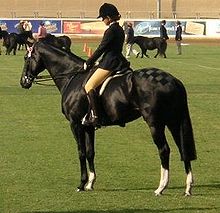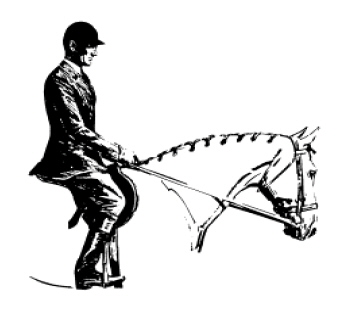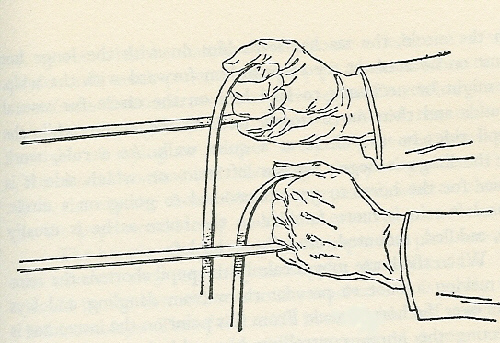IMEHA (International Model Equine Hobbyists Association) was an online photo showing site that existing until 2018. Included on the site were these guidebooks for judging and showing model horses in Performance classes. MEPSA has obtained permission to share the info contained in the guides.
Scoring :: Point Deducts :: Tack :: Rider :: Set-Up Options :: Photo Examples
The show hack is a type of ridden show horse, exhibited to a standard first established in England. Affiliated showing and breeding of the show hacks in the United Kingdom is overseen by the British Show Horse Association.
In the USA and Canada, show hack is solely a form of competition open to various breeds and overseen by the USEF and Equine Canada (EC). The Canadian form of competition is more closely modeled on the British standard than that of the USA.
The show hack is designed for horse’s with exception training. Arabian, Half-Arabian and National Show horses divisions offer Show Hack Classes. Open show Hack Classes are seen in some areas, particularly Canada where the class has a far longer history than in U.S.A. The class is judged on manners, performance, quality and conformation. The Show Hack is neither a Dressage Class nor an English Pleasure Class. The horse should be Arabian, Half-Arabian or NSH of good quality and elegant appearance. Other breeds should specify their class and the division as being held in an Open Horse Show. The gaits called for are: normal, collected, and extended walk, normal, collected and extended trot, normal, collected and extended canter, and hand-gallop. The horse and rider may be asked to halt and rein back on the rail. The horse’s frame should compare to a mid to upper level dressage horse, it should be neither as low as a Western or first-level horse nor as high and tight as an English Pleasure or Park Horse. Action will vary but it will not approach English Pleasure style, high action is either desired nor penalized. In general it is the equivalent of desired hunter pleasure action or slightly higher as the show hack horse must demonstrate impulsion in the collected gaits.
Hacks in the UK must have straight movement and move with “pointed” toes. Individual shows do not need to show a gallop, but should show rein back alongside the usual requirements of halt, walk, trot and canter.
In North American classes, the show hack is to show at extended, regular and collected versions of the walk, trot and canter, as well as performing a hand gallop, halt and the rein back. Particular emphasis is placed on gait transitions and obedience. While fluid, smooth gaits are always desired, a more dressage-like frame is favored. Some show hack classes for specific breeds, particularly those for the Arabian and Morgan, encourage some animated knee action, though in Canada, use of weighted shoes is prohibited.
In Canada, riders may be asked to dismount and remount their horses, and horses may have their saddles removed for conformation judging. Conformation scores may be used to break a tie.
Worldwide, manners are particularly important in the judging of hacks, and any animal behaving badly will be severely penalized in the judging.
You Score Show Hack on the following basis:
Faults to be scored according to severity:
(1) Quick, short or vertical strides
(2) Being on the wrong lead
(3) Breaking gait
(4) Excessive speed at any gait
(5) Excessive slowness in any gait, loss of forward momentum
(6) Failure to take the appropriate gait when called for
(7) Head carried too high
(8) Head carried too low (such that poll is below the withers)
(9) Overflexing or straining neck in head carriage so the nose is carried behind the vertical
(10) Excessive nosing out
(11) Failure to maintain light contact with horse’s mouth
(12) Stumbling
(13) If a horse appears sullen, dull, lethargic, emaciated, drawn or overly tired
(14) Consistently showing too far off the rail
Faults which will be cause for disqualification, except in novice amateur or novice youth, which shall be faults scored according to severity:
(1) Head carried too low (such that poll is below the withers consistently)
(2) Overflexing or straining neck in head carriage so the nose is carried behind the vertical consistently
At the option of the judge, all or just the top 12 horses may be required to hand gallop, one or both ways of the ring. Never more than 12 horses to hand gallop at one time. At the hand gallop, the judge may ask the group to halt and stand quietly on a free rein (loosened rein).
If You Use A Doll Rider:
Rider should have a workmanship appearance, seat and hands, light and supple. Hand should be over and in front of horse’s withers, knuckles 30 degrees inside the vertical, hand slightly apart and making a straight line from the horse’s mouth to rider’s elbow. Method of holding reins is optional. All reins are to be picked up at the same time. Eyes should be up with shoulders back, toes slightly out and ankles flexed in. Heels should be down and calf or leg in contact with horse and slightly behind girth.
The rider should sit in a comfortable, balanced, and relaxed manner while maintaining an erect upper body with eyes up and looking forward.
The rider’s legs should have a slight bend and hang beneath the rider such that when viewed from a profile, a straight line (approximately) can be drawn through the rider’s ear, shoulder, hip and heel.
The irons should be placed under the balls of the feet and not under the toe or against the heel.
Toes should be turned only slightly out with ankles flexed in toward the horse.
The lower leg should be held such that light contact would be maintained with the horse.
Arms and hands should be held in a comfortable, relaxed manner with upper arms held in a straight line with the body. The elbow is bent such that the lower arm and hands are in a straight line to the bit.
Hands should be slightly over and in front of the withers with knuckles 30 degrees inside the vertical.
Position in Motion;
At the walk and slow trot, body should be vertical with slight motion in the saddle.
At a posting trot, the body should be inclined forward with slight elevation in the saddle.
At the canter, the body should be halfway between the posting trot and the walk.
At the gallop, and while jumping, the body should be at a similar inclination as when at a posting trot.
Extra Credit Should Be Given If:
(1) Rein contact is steady but gentle at all times. It is referred to as ‘direct contact’ On a model entry this can be achieved by using sticky wax and makes the rein go in a direct straight line from the bit to the rider’s hand with no slack in the rein.
(2) Bight (Excess rein) of rein is draped on the right.
(3) Mane and tail braided with complementary color also should receive extra credit.
(4) an Entry Number is shown on saddle blanket or on rider’s back.
Points Should Be Deducted If:
(1) Model exhibits excessive speed for gait assigned.
(2) Model is on the wrong lead.
(3) Model appears to display a slowness in any gait or loss of forward momentum resulting in an animated and/or artificial gait at the lope.
(4) Rider touches horse or saddle with free hand.
(4) Model’s head is carried too high.
(5) Model’s head carried too low; tip of ear below the withers.
(6) Model is overflexed or has a strained neck in head carriage, so the nose is carried behind the vertical.
(7) Model displays excessive nosing out.
(8) Model displays an open mouth excessively.
(9) Rider uses spurs forward of the cinch.
(10) Model appears sullen, dull, lethargic, emaciated, drawn or overly tired.
(11) Model appears agitated; has ears back, tail twirled, etc.
(12) Model displays quick, choppy or pony strides.
(13) Reins are draped and not a direct contact.
Required Tack:
English saddle of any type; however, no cutbacks (saddleseat saddles) are used. Bridle must be single snaffle, pelham (kimberwicke permitted but rarely seen) or full bridle; browbands and cavessons acceptable in hunter and dressage classes may be used.
A dressage saddle, although some forward seat saddles are often seen. A square dressage saddle pad most often in black with white piping/edging or white with colored piping/edging is the most used. Standard shaped saddle pad is acceptaqble as well. The current style is to the dressage-style full bridle, although snaffle bridles are also seen. Manes are frequently braided with either the french-braid or smocking for full manes or a standard hunter braid job for pulled manes. Tails may also be braided but are usually left loose. Braids may be secured with yarn, tape, or rubber band, but decorations are not permitted. A checkerboard or other pattern is frequently brushed or clipped into the croup area of the horse.
A standard huntseat turnout is equally acceptable under the rules. Horses performing upper level movements such a passage, pirouette, work on two tracks etc, are not performing to class specifications and must be dropped to the bottom of the class.
Prohibited Tack:
Breastplates, Martingales, Boots or Bandages, Colored Browbands or Cavesson Sets, or any other bridle types not acceptable in hunter or dressage, Single-Curb Bridles, Decorations on Braids, Side Reins, Rein Stoppers, Figure-8, Flash and Drop Nosebands or other devices for controlling the headset are forbidden.
Rider:
The rule specifies informal hunt attire, except in evening classes or championships. Virtually all riders appear in full formal turnout of shadbelly coat, white breeches, canary, buff or yellow vest, black boots, white stock tie, gloves and top hats. Whip and spurs are optional.
Riders may also wear uniforms from Riding Schools just as Spanish Riding School, Oxford Riding School, French Calvary School, etc. The uniform would consist of beeches, uniform jacket, school hat or cap, full boots and white gloves. No Red Hunt Coats. Formal dressage attire is acceptable under USA rules for Show Hack.
Set-Up Options:
Arena Fencing Required (Indoor or Outdoor Arena)
Types of Fencing Allowed:
- Painted or Natural
- Post and Rail
- Post and Plank
- Chain Link
- Solid Plyboard
- Plyboard with Top Rail
- Post with Drape Rope
- Stock Tube Pipe Rail
- Interior Arena Wall
Footing Required:
- Dirt
- Sand
- No rock base
Backboard or Natural Setting (Indoor or Outdoor)
Examples of Show Hack:

Show Hack Entry
DA Sidi Bisgiir Arabian stallion wearing full double bridle again by Corinne Ensor. Horse and doll by Karon Grieve and shown by Karon Grieve.
Doll Rider Correct Seat and Hold the Reins Correctly:

The reins are held between the ring fingers and pinkies with the thumbs solidly on top as they exit the hands. The grip is firm. Close the fingers for optimum communication and safety. Hold the hands just above the horse’s withers, in front of the saddle. Tip the thumbs toward each other at a 45-degree angle. Bend the elbows just enough to create a straight line through the forearms, hands, and reins to the horse’s mouth.
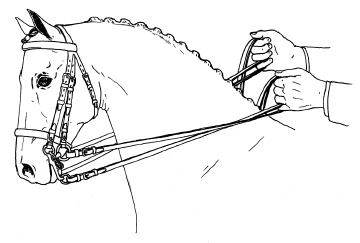
Double Bridle Reins – 2 and 2 Method. Most common handle hold in model horse hobby. It is advised that you put in your comment line what hold your set up is so that judge’s know you understand the three styles on holding the reins.

Double Bridle Reins – 3 in 1 Method. A true challenge for model horse hobbyists and doll rider’s with razor cut slips in the fingers of the hands. Left side curb goes directly back to hand and enters under ring finger with the left snaffle rein coming directly back and entering under the pinky finger with rein crossing over the curb rein. Right side curb rein goes directly back and enters under the middle finger of the left hand with all three reins coming up thru hand and out over the of the index finger with bight cascading down the right side. The right side snaffle goes directly and enters the hand under the ring finger, up into the hand and out over the top of the index finger with the bight draping down the right side. The look gives an ‘X’ to reins the left side of horse’s neck but a two independent rein look to the right side but only one rein going into the right hand. Very tricky set up.
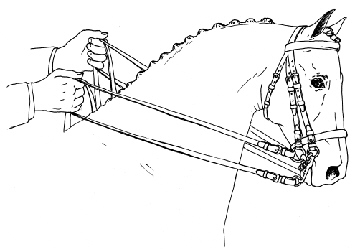
Double Bridle Reins – Fillis Method. The Fillis method of holding the reins is when the curb reins enter the rider’s hand from the bottom, around the little fingers and up to the second joint of the index fingers while the snaffle enters the fist from above over the index fingers. Each hand holds two reins.

